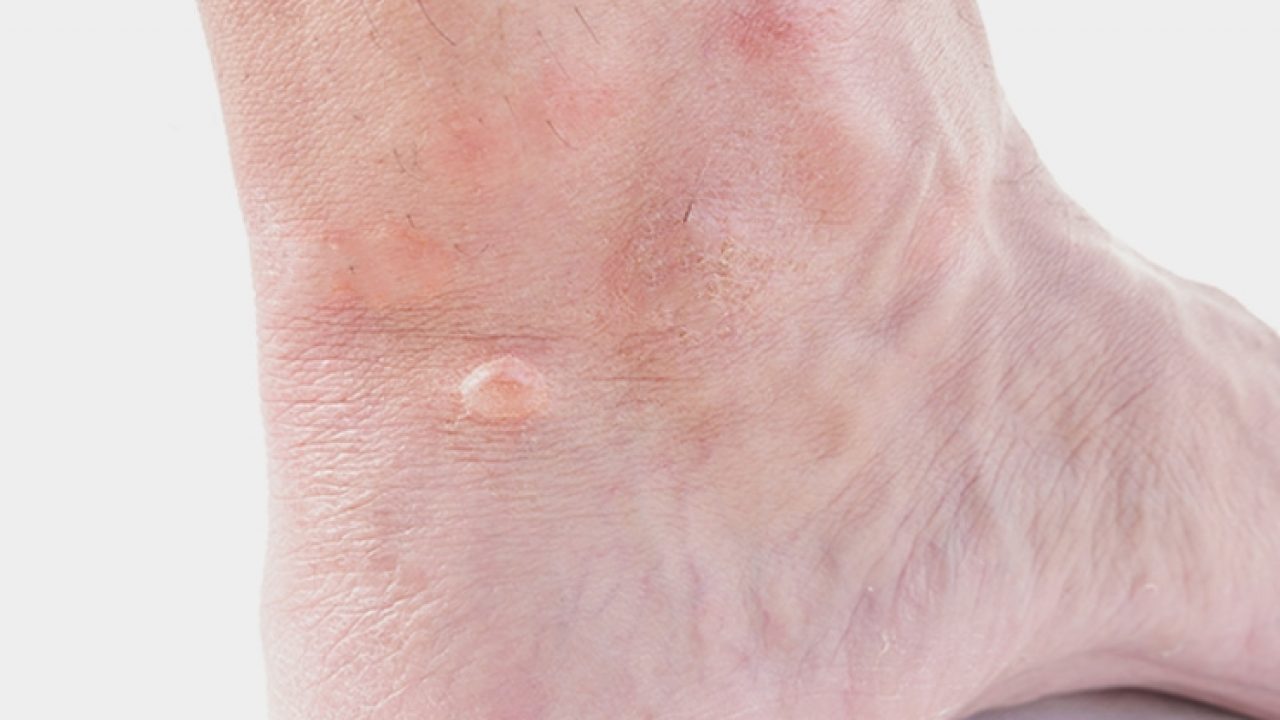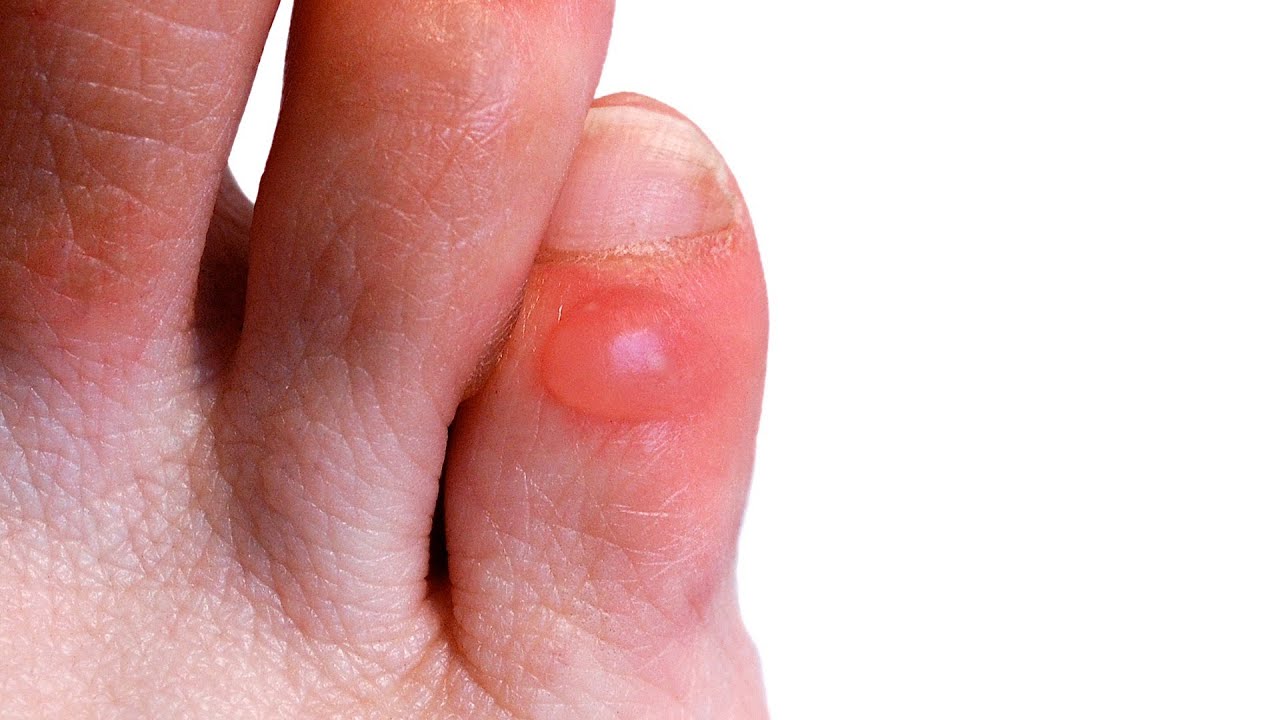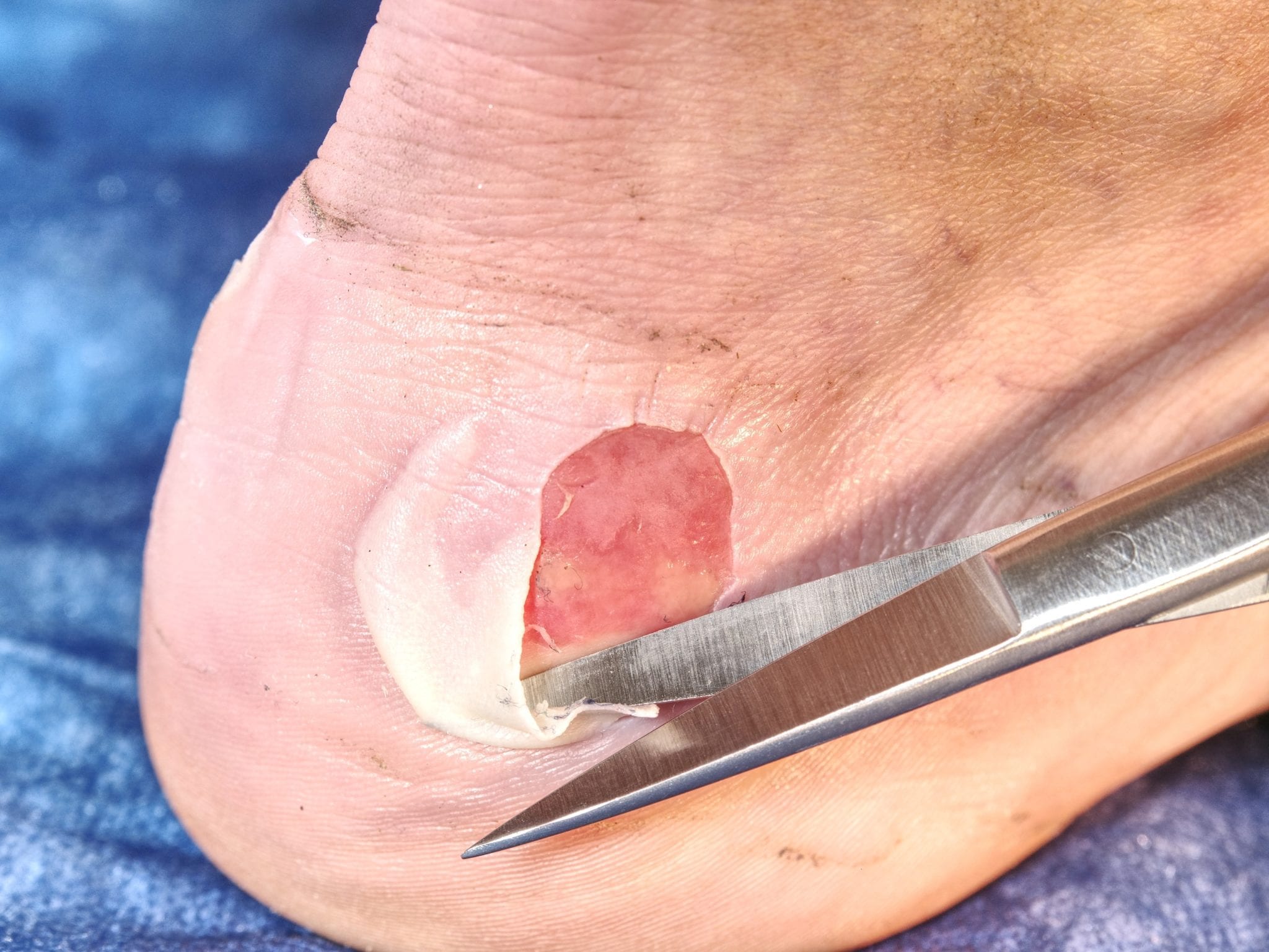A. Blisters on Feet: What You Need to Know
We offer products that we believe are useful for our readers. If you buy through the links on this page, we can earn a small commission. Here is our process.
1. Blisters on the feet
The bladder is a small bag of fluid that forms in one area of the body. These bubbles can vary in size and appear for several reasons. You can develop one after a skin burn, a yeast or bacterial infection, an insect bite or trauma. Depending on your location, the bladder can interfere with normal daily tasks. For example, if you have blisters on your feet, you may have difficulty walking, exercising, or standing for long periods.
Blisters usually develop on the feet. Fortunately, several home treatments can relieve discomfort and reduce the risk of recurrent blisters.
2. Causes of blisters on the feet
If you have blisters on your feet, friction may be the culprit. Walking or standing several hours a day puts pressure on your heels, soles and toes. The longer you stand during the day, the greater the risk of blisters on your feet.
Of course, not everyone who walks or stands for long periods will develop blisters. In many cases, these liquid-filled bladders result from poorly fitting shoes. Shoes that are too tight or too wide can rub against the skin. This causes friction and, as a result, fluid builds up under the top layer of the skin.
Excessive moisture or sweat can also cause skin blisters. This is common for athletes, especially runners, in the hot season. Small bubbles form when sweat clogs the pores of your feet.
Blisters on the feet can also develop after a sunburn. Other possible causes of blisters on the feet include:
- Cold burn
- Allergic reaction
- Chemical exposure (cosmetics or detergents)
- Fungal infections
- Chickenpox
- Bacterial infection
- Herpes
- Dyshidrotic eczema
3. Diagnosing blisters on the feet
A blister on the foot caused by friction usually clears up within a few days with home treatments.
Unfortunately, some blisters do not respond to home treatments or may get worse over time. Consult a doctor if a blister causes severe pain or prevents you from walking. You should also see a doctor if fever, nausea, or chills accompany a blister on your foot. This can be a sign of infection.
Your doctor may use a sterile needle to empty your bladder. If they suspect an infection, they can examine a sample of the fluid to determine the cause.
4. Home treatments for blisters on the feet
You may be tempted to pop or pop a bubble. However, you must leave the bladder intact, as an open bladder can infect. Covering the bladder with adhesive tape can help protect it during healing.
Eventually, if you leave a bubble alone, it can harden and go away. Until that happens, the blister can be uncomfortable depending on its size. Although you shouldn’t pop your bladder, emptying it safely can help. Here are the steps to properly empty a bladder at home:
- Wash your hands with warm water and antibacterial soap.
- Disinfect a needle with a cotton swab with alcohol.
- Clean the bladder with an antiseptic.
- Take the needle and make a small puncture in the bladder.
- Allow the liquid to drain completely from the bladder.
- Apply an antibacterial ointment or cream to the blister.
- Cover the blister with a bandage or gauze.
- Clean and reapply the antibacterial ointment daily. Keep the blister covered until it heals.
5. How to prevent blisters on your feet
To avoid blisters on your feet, you need to address the underlying cause. If you develop blisters due to friction, wearing appropriate shoes is your first line of defense. If your feet touch a specific area of the shoe, using an insole can provide extra cushioning and reduce friction.
B. Ways to get rid of blisters
Blisters are pockets of fluid that form on the skin in response to friction, heat or infection. Blisters can heal on their own, but natural products can speed up the healing process.
The epidermis, or upper layer of the skin, acts as a physical barrier between the lower layers of the skin and the external environment. The skin bubbles here to protect itself from irritation, such as constant friction or pressure.
The blisters also allow time for the skin to heal. People should avoid bursting or blistering, as the skin keeps germs out and prevents infections.
Keep reading to learn more about the best natural home remedies for blisters.
1. Feet, toes and heels
- Blisters on the feet and toes are usually caused by friction.
- The use of ill-fitting shoes is a common cause of friction bubbles. Wearing strappy sandals, such as slippers, that can rub against your toes can cause friction bubbles on the inside of the toe.
- The blisters in these areas can disappear quickly if the person addresses the cause of the irritation.
- For example, if a pair of shoes causes blisters, the skin will take time to heal if you change to a better-fitting or more comfortable pair for a few days.
- Instead of wearing strappy sandals or high-heeled shoes, wear comfortable, tight shoes for a few days so your feet have time to heal.
People can also cover the blisters with tape or gauze to prevent further friction. Applying petroleum jelly to the area before covering it can also help, as it will reduce friction in the area.
2. Natural remedies for blisters on the feet, toes and heels include
a. Aloe Vera
Aloe vera leaves contain a gel-like substance known for its healing properties.
- A systematic review concludes that aloe vera gel compounds reduce inflammation, increase collagen production and stimulate cell regeneration, which can promote more efficient healing.
- According to the results of a 2018 randomized controlled study, aloe vera gel improved healing in people who underwent skin grafts for burns. Although aloe vera gel has shown impressive healing benefits, it has not resulted in significant pain relief.
- People can buy ointments and skin products that contain aloe vera over the counter. You can also apply the pure aloe vera gel directly to the blister.
- People should note that none of these studies looked at aloe vera for friction bubbles. There is no guarantee that aloe vera will bring more benefits than something like plain petroleum jelly or nothing.
However, due to the low risk of side effects, it may be worth a try.
b. Vaseline
Common petroleum jelly is a favorite among dermatologists for treating wounds.
Although the blister itself acts as a cover for the wound, a person can cover the area with petroleum jelly and a bandage if it breaks. This can promote healing in the area.
c. Finger
- Blisters on the fingers and palms can occur as a result of a skin disease called dyshidrotic eczema or dyshidrosis.
- Dyshidrosis is a type of eczema that causes dry and itchy skin and small blisters on the hands and feet.
- According to the American Academy of Dermatology, there is no cure for dyshidrosis and relapses usually last between 2 and 3 weeks.
- Although there are several over-the-counter and prescription treatments for eczema, the National Eczema Association estimates that more than 50% of affected people use complementary and alternative medicine to control their symptoms. It is best to use complementary medicine as a complement to conventional therapy.
3. Natural remedies for dyshidrosis and other eczema-related blisters include
a. Marigold
Marigold comes from marigold plants. It contains several antioxidants that can reduce inflammation and promote skin healing.
Although marigold appears safe for topical use, contact dermatitis can occur. Marigold users for the first time should test a small amount on the skin before using it to treat blisters or other sensitive areas of the skin.
b. Coconut oil
Coconut oil contains lauric acid, a type of fatty acid that can help moisturize your skin and reduce inflammation. As a result, coconut oil can promote tissue repair and improve wound healing.
People can dip a cotton ball in the melted coconut oil and gently tap the oil into the bubble.
c. Lips
Viral infections can cause blisters to appear on the lips.
- For example, the herpes simplex virus (HSV) is a common viral infection that can cause cold sores and genital herpes.
- HSV-1 infection causes recurrent sores, which are small blisters or boils that appear around the mouth and lips.
- According to the Centers for Disease Control and Prevention (CDC), approximately 48.1% of people aged 14 to 49 years in the United States were infected with HSV-1 in 2015-2016.
- Cold sores usually heal on their own, but can cause swelling, pain and irritation.
4. A natural remedy for cold sores is lemon balm
a. Lemongrass
- Melissa officinalis compounds, also known as lemon balm, can have antiviral effects.
- According to a 2017 review article, lemon balm can suppress HSV in the early stages of infection.
- Lemon balm can also help to reduce the inflammation and pain associated with HSV infections.
- People can dilute lemon balm oil with water and apply the mixture to the wounds with a cotton swab.
C. How to Get Rid of a Blister
We offer products that we believe are useful for our readers. If you buy through the links on this page, we can earn a small commission. Here is our process.
1. What is a bubble
Blisters are small, fluid-filled blisters that can form on the outer layers of the skin. They protect your body from damaged skin. Therefore, it is generally best to leave them alone. Blisters are wounds that take time to heal. However, there are steps you can take to relieve pain and discomfort.
Most bubbles are the result of friction. They form when something rubs against your skin, such as an ill-fitting shoe or the handle of a shovel. Other possible causes of blisters include:
- Burns
- Sunburn
- Cold burn
- Eczema
- allergic reaction
- Exposure to poison ivy, oak or sumac
- Viral infections like herpes, shingles or chickenpox
- Bacterial infections
2. Leave it alone
Most blisters heal spontaneously in a few days. The fluid-filled skin blister is actually a natural form of protection that protects the wound from harmful bacteria. The blisters also provide a safe space for the growth of new skin.
As the new skin grows, your body slowly absorbs the fluid. After a few days, your bladder will dry and peel. Removing a dry blister can affect the healing time. Therefore, it is better to leave them alone. This also greatly reduces the likelihood of infection.
3. Protect it
Some bubbles may need extra protection to prevent them from bursting. For example, a blister on the back of the heel can be caused by pressure from the shoes. This can not only cause severe pain, but it can also increase the bladder healing time.
Whenever possible, it is best to avoid rubbing the area with your bladder. However, this is not always possible. In that case, there are several things you can do to cushion your bladder and prevent it from bursting:
- Cover it. Cover the bladder with a loose dressing. You can use normal tape or gauze taped in place. Your bladder needs air to dry. Therefore, keep the center of the band slightly raised for airflow.
- Pad. You can also cover the bladder with a padded tape specially designed for blisters. It can keep bacteria away and relieve pain while the bladder heals.
- Pad. Avoid putting pressure on your bladder by cutting a piece of donut-shaped mole skin. Moleskin has a thick cotton lining that can absorb pressure. Periodically cover the upholstery with a bandage to keep bacteria away.
4. Try natural remedies
In addition to protecting your bladder, you can also try some natural remedies to aid in the healing process.
a. Aloe vera
If you have blisters from a minor burn or sunburn, the application of aloe vera gel can help ease the pain. For additional relief, keep it in the refrigerator. The cold temperature will help keep the heat away from your skin.
In addition, a 2016Trusted Source study on wound healing in rats found that aloe vera reduced inflammation, promoted healing, and reduced the size of scar tissue.
b. Green Tea
Green tea has antioxidant and anti-inflammatory properties that can promote wound healing. A recent study A Trusted Source of green tea extract mixed in an ointment found that it reduced wound pain and promoted better and faster healing.
You can mix the green tea extract with a carrier oil such as coconut or almond oil and apply it directly to the blister. A green tea can also be prepared. Place the tea bag in your bladder after you rinse it under cold water.
c. Tea tree oil
Tea tree oil has antibacterial and anti-inflammatory properties that can help reduce the risk of infection and accelerate healing. Several studies have demonstrated the powerful antibacterial effects of tea tree oil, even in surgical wounds.
Tea tree oil can be mixed with a carrier oil and applied directly on the skin. Tea tree oil can also be diluted with water and used as an antibacterial wash.
d. Eucalyptus Oil
Eucalyptus oil has antiseptic and antimicrobial properties that can help to clean and disinfect wounds. Studies suggest it can ward off strong bacteria such as Escherichia coli and Staphylococcus aureus.
You can mix eucalyptus oil with any carrier oil, but a recent Trusted Source study suggests that mixing it with olive oil may actually increase its healing properties. Mix a few drops of eucalyptus oil in 1 teaspoon of olive oil. You can apply this directly to your bubble or dilute it further with 1 tablespoon of cocoa butter.
5. Empty it
Although it is better to leave the bubbles alone, sometimes it is enough to empty them, especially if they are very large or if they are in an uncomfortable place. However, avoid deflating bubbles on your lips or around your mouth. This area is difficult to cover and keep sterile.
Never try to burst a blister like a pimple. Its purpose is to drain the liquid without damaging the skin covering the blister. If you want to drain a bleb, you must do so within 24 hours of its formation.
Follow these steps to safely empty a bleb and minimize the risk of infection:
- Wash your hands and bladder. Wash your hands with soap and warm water. Carefully wipe the surface of the bladder with alcohol, iodine, or an antiseptic wash.
- Disinfect a needle with alcohol. Dip a needle in alcohol to disinfect it.
- Carefully prick the blister. Make three or four shallow holes around the edge of the bubble. Let the liquid drain.
- Cover the bubble with ointment. Apply an ointment, such as Vaseline, over the bubble.
- Apply a bandage. Cover the bubble well with a bandage or gauze. Want the roof intact to press against the skin below.
- Repeat the process. Bubbles tend to re-inflate quickly. During the first 24 hours, it may be necessary to do these steps every six to eight hours. After that, change the dressing and apply the ointment daily.
6. When to consult a doctor
Whether they drain or not, the bubbles are prone to infection. Untreated infections can be painful and require the administration of antibiotics. In addition, some blisters are caused by something more serious than friction.
Call your doctor if:
- The blister is filled with yellow or green pus.
- The area is red, inflamed, or hot.
- The pain becomes worse instead of better.
- Your blisters are in unusual places, like your mouth or eyes.
- Your blister keeps coming back.
- You have symptoms of an allergic reaction.
7. Bubble prevention
Bubbles can be unavoidable, especially when breaking a new pair of shoes. However, there are steps you can take to reduce your risk:
- Use moisture-absorbing socks instead of cotton socks to help reduce moisture.
- Apply mole skin or tape to areas with common blisters, such as the heels.
- Use a powder for feet or antiperspirant to help reduce moisture.
- Use two pairs of socks to redistribute friction.
- Apply petroleum jelly in areas of high friction.
- Wear work gloves when shoveling and raking.
- Wear loose clothing that absorbs moisture.
- Avoid wearing shoes that are too big or too small.
8. The final result
Bubbles are a common problem for many people. They can interfere with the activities you love, such as hiking and running. While it is better to let the bubbles heal on their own, sometimes it is necessary to drain them. Regardless of what you choose to do, make sure the area is clean and protected until the blister heals completely.











